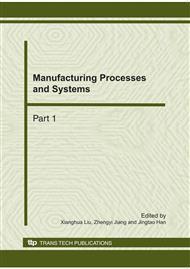p.1571
p.1575
p.1580
p.1584
p.1588
p.1594
p.1600
p.1607
p.1611
Effect of Different Compacting Processes on the Microwave Sintering Behavior of LaNbO4/MoSi2 Composites
Abstract:
The green bodies of LaNbO4/MoSi2 composite materials were compacted by warm pressing and cold pressing processes, and then the composites were prepared by microwave sintering. Effects of the two different compaction processes on sintering process and sintered samples were analyzed. The results show that the density of the microwave sintered sample by cold pressing (5.599g/cm3) is similar to that of warm pressing (5.593 g/cm3). But cold pressing has some disadvantages, such as longer sintering time, incomplete sintered samples, peeling easily on the surface and delaminating, existing internal stress, having microcrack and impurities, and occurring distortion easily in sintered samples. The samples compacted by warm pressing have higher heating rate in the microwave sintering process, which have more homogeneous structures, no clear microcrack and big cavities, and higher fracture toughness after sintering. Compared with cold pressing, the comprehensive properties of warm pressing are better.
Info:
Periodical:
Pages:
1588-1593
Citation:
Online since:
October 2010
Authors:
Price:
Сopyright:
© 2011 Trans Tech Publications Ltd. All Rights Reserved
Share:
Citation:


